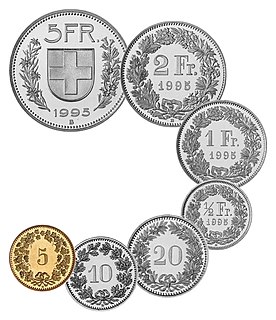The Australian dollar is the currency of Australia, including its external territories: Christmas Island, Cocos (Keeling) Islands, and Norfolk Island. It is officially used as currency by three independent Pacific Island states: Kiribati, Nauru, and Tuvalu. It is legal tender in Australia. Within Australia, it is almost always abbreviated with the dollar sign ($), with A$ or AU$ sometimes used to distinguish it from other dollar-denominated currencies. The $ symbol precedes the amount. It is subdivided into 100 cents.

In macroeconomics, the money supply is the total value of money available in an economy at a point in time. There are several ways to define "money", but standard measures usually include currency in circulation and demand deposits. The central bank of each country may use a definition of what constitutes money for its purposes.

Federal Reserve Notes, also United States banknotes, are the currently issued banknotes of the United States dollar. The United States Bureau of Engraving and Printing produces the notes under the authority of the Federal Reserve Act of 1913 and issues them to the Federal Reserve Banks at the discretion of the Board of Governors of the Federal Reserve System. The Reserve Banks then circulate the notes to their member banks, at which point they become liabilities of the Reserve Banks and obligations of the United States.

A banknote is a type of negotiable promissory note, made by a bank or other licensed authority, payable to the bearer on demand. Banknotes were originally issued by commercial banks, which were legally required to redeem the notes for legal tender when presented to the chief cashier of the originating bank. These commercial banknotes only traded at face value in the market served by the issuing bank. Commercial banknotes have primarily been replaced by national banknotes issued by central banks or monetary authorities.
Legal tender is a form of money that courts of law are required to recognize as satisfactory payment for any monetary debt. Each jurisdiction determines what is legal tender, but essentially it is anything which when offered ("tendered") in payment of a debt extinguishes the debt. There is no obligation on the creditor to accept the tendered payment, but the act of tendering the payment in legal tender discharges the debt.

The franc is the currency and legal tender of Switzerland and Liechtenstein; it is also legal tender in the Italian exclave of Campione d'Italia. The Swiss National Bank (SNB) issues banknotes and the federal mint Swissmint issues coins.

Fractional-reserve banking, the most common form of banking practiced by commercial banks worldwide, involves banks accepting deposits from customers and making loans to borrowers while holding in reserve an amount equal to only a fraction of the bank's deposit liabilities. Bank reserves are held as cash in the bank or as balances in the bank's account at a central bank. The country's central bank determines the minimum amount that banks must hold in liquid assets, called the "reserve requirement" or "reserve ratio". Banks usually hold more than this minimum amount, keeping excess reserves.

The United States one-hundred-dollar bill ($100) is a denomination of United States currency. The first United States Note with this value was issued in 1862 and the Federal Reserve Note version was launched in 1914, alongside other denominations. Statesman, inventor, diplomat, and American founding father Benjamin Franklin has been featured on the obverse of the bill since 1914. On the reverse of the banknote is an image of Independence Hall in Philadelphia, which has been used since 1928. The $100 bill is the largest denomination that has been printed and circulated since July 13, 1969, when the denominations of $500, $1,000, $5,000, and $10,000 were retired. As of December 2018, the average life of a $100 bill in circulation is 22.9 years before it is replaced due to wear.
Notaphily is the study and collection of paper currency, and banknotes. A notaphilist is a collector of banknotes or paper money, particularly as a hobby.
The vatu is the currency of Vanuatu. The vatu has no subdivisions.

National Bank Notes were United States currency banknotes issued by National banks chartered by the United States Government. The notes were usually backed by United States bonds the bank deposited with the United States Treasury. In addition, banks were required to maintain a redemption fund amounting to five percent of any outstanding note balance, in gold or "lawful money".
Federal Reserve Bank Notes are banknotes that are legal tender in the United States issued between 1915 and 1934, together with United States Notes, Silver Certificates, Gold Certificates, National Bank Notes and Federal Reserve Notes. They were specified in the Federal Reserve Act of 1913 and had the same value as other kinds of notes of similar value. Federal Reserve Bank Notes are different from Federal Reserve Notes in that they are backed by one of the twelve Federal Reserve Banks, rather than by all collectively. Federal Reserve Bank Notes were envisioned as a replacement for National Bank Notes, but that did not prove to be the case. They were backed in a similar way to National Bank Notes, using U.S. bonds, but issued by Federal Reserve banks instead of by chartered National banks. Federal Reserve Bank Notes are no longer issued; the only U.S. banknotes still in production since 1971 are the Federal Reserve Notes.
The pound was the currency of New Zealand from 1840 until 1967, when it was replaced by the New Zealand dollar.
The Del Monte note is a misprinted U.S. twenty-dollar bill on which a multicolored Del Monte sticker appears next to Andrew Jackson's portrait. The sticker became affixed during the printing process, prior to the application of the overprint but after the face print had been made. The result is a note with part of the seal and serial numbers printed on top of the sticker. In the paper money hobby, this error type is called a "retained obstruction." The vast majority of such errors do not retain the source of the obstruction but those that do sell for a substantial premium. The note is very famous among currency collectors and has appeared on the covers of industry magazines such as Bank Note Reporter and Numismatic News.

The Australian ten-dollar note was issued when the currency was changed from the Australian pound to the Australian dollar on 14 February 1966; it replaced the £5 note which included the same blue colouration. There have been four different issues of this denomination, a paper banknote, a commemorative hipolymer note to celebrate the bicentennial of Australian settlement, the 1993-2017 polymer note, and from September 2017 a polymer note featuring a transparent window.

Money is any item or verifiable record that is generally accepted as payment for goods and services and repayment of debts, such as taxes, in a particular country or socio-economic context. The main functions of money are distinguished as: a medium of exchange, a unit of account, a store of value and sometimes, a standard of deferred payment. Any item or verifiable record that fulfils these functions can be considered as money.

The United States dollar is the official currency of the United States and its territories per the Coinage Act of 1792. One dollar is divided into 100 cents, or into 1000 mills for accounting and taxation purposes. The Coinage Act of 1792 created a decimal currency by creating the dime, nickel, and penny coins, as well as the dollar, half dollar, and quarter dollar coins, all of which are still minted in 2021.

In monetary economics, the currency in circulation in a country is the value of currency or cash that has ever been issued by the country’s monetary authority less the amount that has been removed. More broadly, money in circulation is the total money supply of a country, which can be defined in various ways, but always includes currency and also some types of bank deposits, such as deposits at call.

Birds of Canada is the fifth series of banknotes of the Canadian dollar issued by the Bank of Canada and was first circulated in 1986 to replace the 1969 Scenes of Canada series. Each note features a bird indigenous to Canada in its design. The banknotes weigh 1 gram with dimensions of 152.40 by 69.85 millimetres. It was succeeded by the 2001 Canadian Journey series.
The 200 yen note (二百円紙幣) was a denomination of Japanese yen issued from 1927 to 1946. These issues were broken up into three different designs including one which has two different varieties. For whatever reason two-hundred yen banknotes were not issued when they were first authorized. The first issuance came as the result of a financial emergency that took place in 1927. Second series notes were also printed for the emergency, but were placed in storage until the end of World War II. By the time these were released along with a third series of notes, things were changing in Japan's monetary system. Currency could no longer be converted into gold coins making the messages on the long unreleased second series notes obsolete. An end to the series ultimately came in 1946, when all 200 yen bills were demonetized. These notes are now collectables which trade on the marketplace for amounts dependent on condition and rarity.












